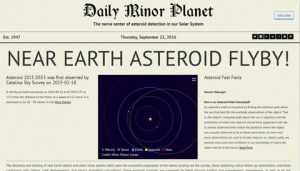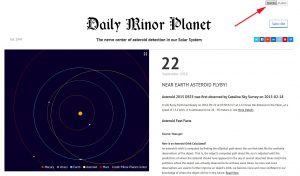A new e-digest from the International Astronomical Union’s Minor Planet Center gives the public a head’s up on passing asteroids.

Daily Minor Planet
Asteroids buzz Earth all the time. Most you never hear about. But for those folks itching with curiosity — or who want a level-headed take on whatever object has blazed its way into the news — the Minor Planet Center’s new initiative is for you.
It’s called the Daily Minor Planet. (No, it’s not staffed by mini versions of Clark Kent.) The Daily Minor Planet is an alert service that sends an e-mail once a day to your inbox with information about any passing near-Earth objects. It includes the object’s name, time of closest approach (in Universal Time), speed, size, distance (compared with the Moon), and an orbit diagram. A link takes you to the object’s entry in the Minor Planet Center’s database, where the data-enthused can find more details.
On days when there’s no interplanetary visitor whizzing past Earth, the report will feature a recently discovery asteroid.
Every day, the e-alert will also either include “asteroid fast facts” — stuff like how scientists calculate an asteroid’s orbit — or highlight an article in the popular press. (Pick mine, pick mine!)

The web version lets you view the Daily Minor Planet in two modes: minimalist web style (“modern”) and old-timey newspaper style (“classic”).
The idea behind the project is to provide the public with no-nonsense info about passing asteroids, to counter hype in the media. However, currently there’s no public archive, so you’ll need to either check the website daily or save your e-mails to keep up. If you’re not looking too much in the past, you can use the table that’s tucked away on the right side of the Asteroid Hazards video page. It’s at the bottom of the column labeled Running Tallies. This table lists close approaches within the last week and those upcoming in the next couple of weeks, but it only includes the name, date/time, distance, and size.
The digest isn’t designed for observers; it doesn’t include things like apparent magnitude. For those looking to spot these objects, you’ll need an ephemeris generator. The Minor Planet Center has one, as does JPL and the European NEODys-2 site.
Read more about the new initiative in the press release from the Harvard-Smithsonian Center for Astrophysics.
Find oodles of fun in Sky & Telescope's online store.
 0
0
Comments
You must be logged in to post a comment.